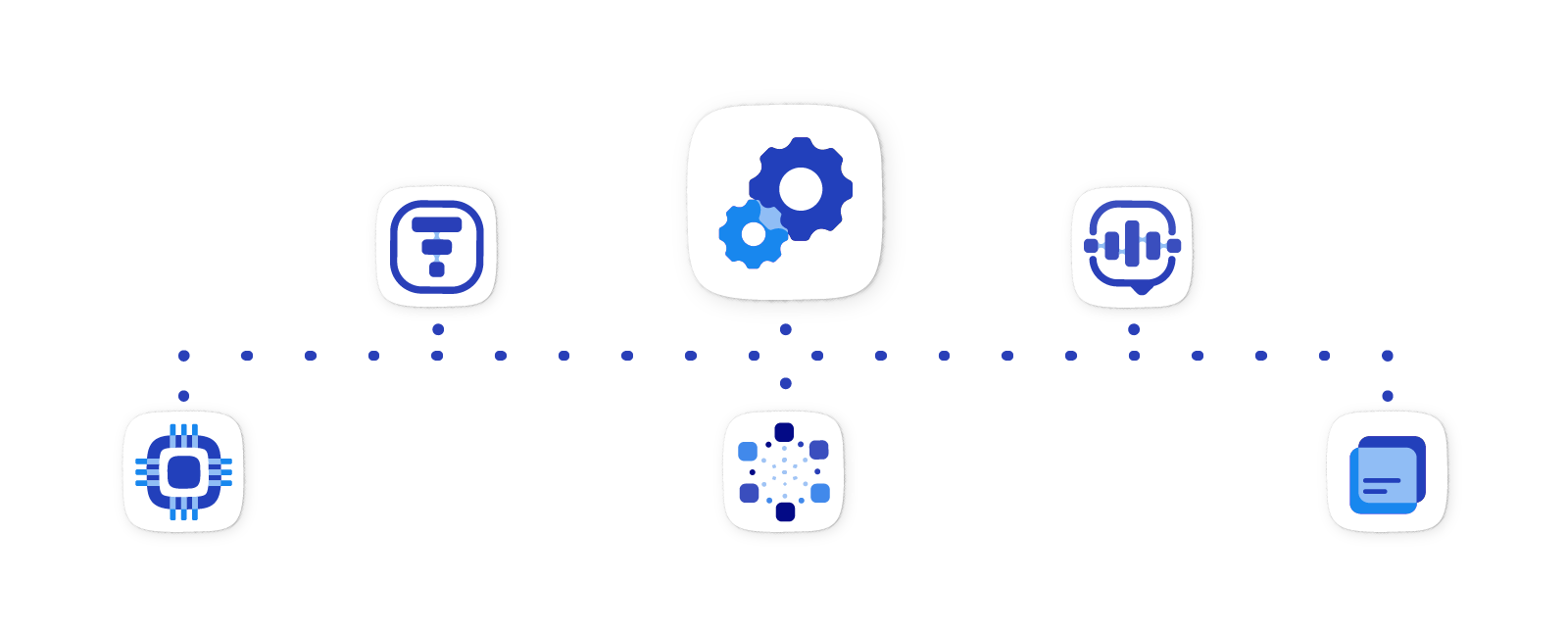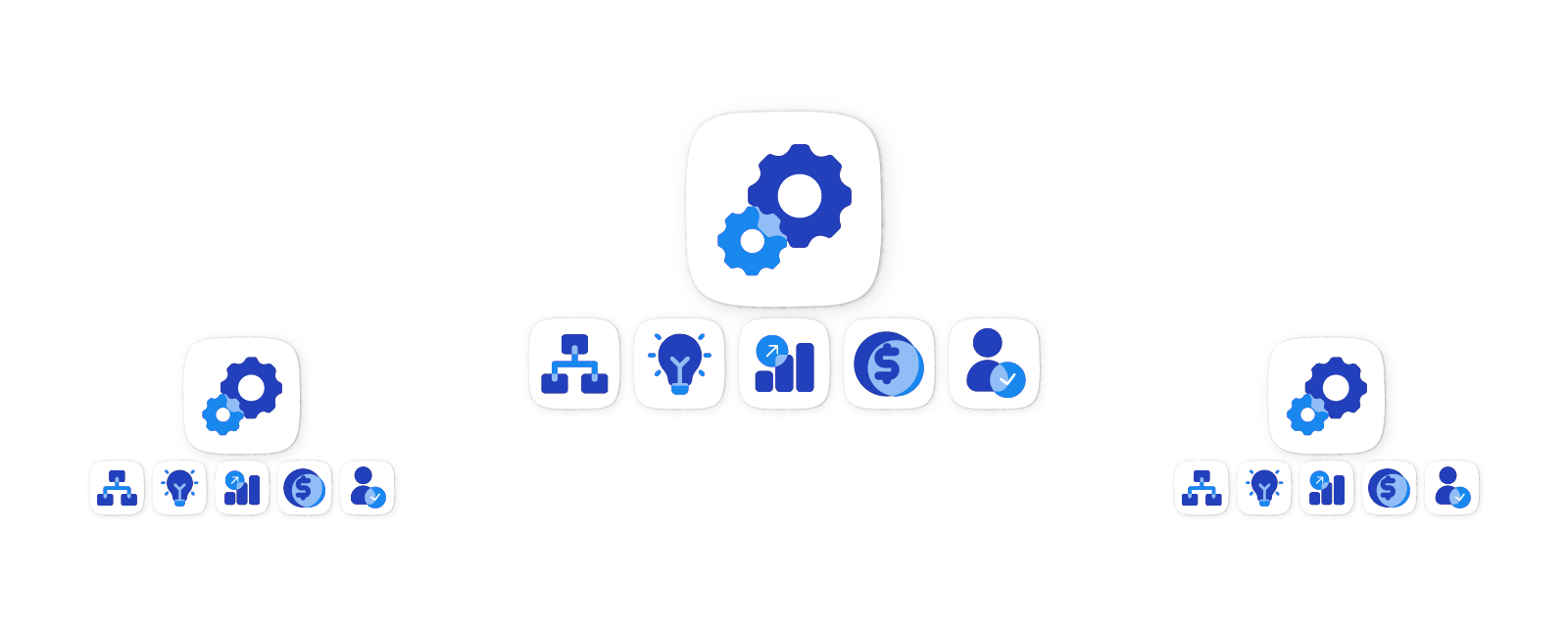Hyperautomation combines advanced technologies like artificial intelligence (AI), machine learning (ML), and robotic process automation (RPA) to create a comprehensive system capable of handling complex tasks, learning from experience, and adapting to changing circumstances.
As a result, it offers enterprises significant benefits, such as improved efficiency, reduced errors, cost savings, better decision-making, and increased scalability.
In this article, we’ll provide a comprehensive guide to hyperautomation, including strategies, tools, and best practices, to help businesses understand the concept and maximize its potential. We’ll discuss how to start with hyperautomation, which technologies to use, and how to overcome challenges, drawing from real-world examples and expert insights.
What Is Hyperautomation?
Hyperautomation is an advanced form of automation that uses sophisticated technologies to automate complex business processes, augment human capabilities, and empower decision-making.
Unlike traditional automation, which typically focuses on replicating repetitive, rule-based tasks, hyperautomation extends beyond simple task automation to provide comprehensive, end-to-end process automation.
At its core, hyperautomation is underpinned by several key components:
Robotic Process Automation (RPA)
RPA is the backbone of hyperautomation, automating repetitive tasks traditionally performed by humans. It uses software robots, or “bots,” to execute routine tasks quickly and accurately, reducing manual effort and improving efficiency.
Artificial Intelligence (AI) and Machine Learning (ML)
AI and ML are the brains behind hyperautomation. They provide the ability to analyze, learn from, and make decisions based on large amounts of data. They can enhance RPA by enabling bots to handle more complex tasks and make predictive and prescriptive recommendations.
Process Mining and Task Mining
These tools help identify the processes that could benefit most from automation. Process mining looks at the overall process flow within a system, while task mining focuses on individual user tasks, providing a granular view of processes.
Intelligent Business Process Management Suites (iBPMS)
iBPMS is a software platform that integrates several technologies, including RPA, AI, and ML. It provides the tools to model, implement, execute, monitor, and optimize business processes, enabling continuous improvement.
Digital Twin of an Organization (DTO)
A DTO is a virtual model of an organization that replicates its processes, resources, and systems. It helps visualize how changes affect operations before implementation, allowing for risk-free experimentation and optimization.
By integrating these technologies, hyperautomation enables businesses to go beyond conventional automation capabilities, leading to more intelligent, efficient, and flexible operations.
It represents a shift from task-based automation to an interconnected and interoperable automation strategy, transforming how businesses operate and compete in the digital era.
Traditional Automation vs. Hyperautomation
Hyperautomation and traditional automation significantly differ in their approach, scope, and capabilities, and hyperautomation is often the better fit for enterprise organizations.
Traditional Automation
Traditional automation primarily focuses on automating specific repetitive tasks with little consideration for the broader business process. In contrast, hyperautomation takes a more holistic approach, addressing the entire life cycle of a process, from discovery and analysis to optimization and continuous improvement.
Traditional automation is usually limited to well-defined tasks, while hyperautomation extends to more complex, dynamic processes. It combines advanced technologies like AI, ML, and iBPMS to create a comprehensive automation ecosystem capable of handling a wider range of tasks and decision-making processes.
In terms of capabilities, traditional automation, which primarily relies on RPA, can handle simple, rule-based tasks, but it cannot adapt to changing conditions or make intelligent decisions.
Hyperautomation
Hyperautomation brings AI and ML into the mix, enabling the system to analyze data, learn from it, and make informed decisions based on patterns and insights. This allows for the automation of more complex tasks and the ability to react to changes in the business environment.
Where traditional automation might struggle to scale across an organization due to its requirement for significant manual effort and its limitations in handling complex tasks, hyperautomation allows for greater scalability. It automates complex processes, reduces manual intervention, and leverages AI and ML to adapt to changing requirements and conditions.
Moreover, traditional automation typically offers a one-time, fixed solution, while hyperautomation focuses on continuous improvement and adaptation.
By using process mining, task mining, and iBPMS, hyperautomation enables organizations to continuously monitor, analyze, and optimize their processes, fostering a culture of ongoing innovation and improvement.
For enterprise organizations, the advantages of hyperautomation over traditional automation are clear. With its holistic approach, broader scope, enhanced capabilities, scalability, and focus on continuous improvement, hyperautomation is better suited to address the complex, dynamic challenges that large organizations face in the digital era.
By embracing hyperautomation, enterprises can unlock unprecedented operational efficiency, agility, and competitive advantage, positioning themselves for long-term success.
Hyperautomation Examples
Hyperautomation has significantly impacted various industries by streamlining processes, improving efficiency, and reducing costs. Here are some real-world examples of hyperautomation in finance, manufacturing, and healthcare:
Finance
JP Morgan Chase: The global banking giant developed a Contract Intelligence (COiN) platform, which employs hyperautomation to review legal documents and extract important data points and clauses. This implementation has significantly reduced the hours that legal teams spend on manual reviews, allowing them to focus on more strategic tasks.
Manufacturing
Siemens: The multinational engineering company leverages hyperautomation for predictive maintenance and real-time monitoring of their shop floor machinery. By analyzing data from their IoT devices, Siemens can predict failures before they occur, minimizing downtime and improving operational efficiency.
Healthcare
Mayo Clinic: The renowned medical center has implemented a hyperautomation solution to automate the entering of patient data into electronic health records (EHRs). This has significantly reduced manual effort and errors, improved data accuracy, and enabled healthcare professionals to devote more time to patient care.
Retail
Amazon: The e-commerce giant uses hyperautomation in its warehouses. It employs robots to pick, pack, and ship items to enhance the speed and efficiency of its operations. It also uses AI and ML for demand forecasting and personalized recommendations, optimizing inventory management and enhancing the customer experience.
Telecommunications
Verizon: The telecommunications company uses hyperautomation for network fault detection and resolution. Using AI and ML, they can predict network faults before they occur and automate the resolution process, improving network reliability and customer service.
These examples demonstrate how hyperautomation not only enhances operational efficiency but also drives innovation and competitive advantage across various industries.
Benefits of Hyperautomation
Implementing hyperautomation in various industries leads to many benefits.
In finance, hyperautomation streamlines processes like data entry, compliance, and risk assessment, resulting in enhanced efficiency, reduced errors, and faster service delivery. Automating routine tasks allows financial institutions to allocate more time to strategic activities, such as analyzing complex financial data and providing personalized financial advice.
For manufacturing industries, hyperautomation is crucial in automating production lines, optimizing inventory management, and improving quality control. This translates to increased operational efficiency, cost reduction, and minimized errors.
Leveraging automation technologies like robotics and machine learning enables predictive maintenance, which ensures machines are serviced proactively, reduces downtime, and maximizes productivity.
In healthcare, hyperautomation improves patient care, enhances data accuracy, and reduces administrative burdens. By automating data entry, appointment scheduling, and insurance claims processing, healthcare professionals can allocate more time to patient care.
Furthermore, integrating AI and ML technologies facilitates accurate diagnoses, personalized treatment plans, and improved patient outcomes through advanced analysis of patient data.
In the retail industry, hyperautomation optimizes inventory management, enhances the customer experience, and enables personalized marketing.
Automating inventory tracking, demand forecasting, and order processing helps retailers maintain optimal stock levels, minimize stockouts, and improve supply chain efficiency. Automation tools enable personalized customer interactions, tailored recommendations, and seamless omnichannel experiences.
For telecommunications, hyperautomation enhances the reliability and efficiency of networks. AI-driven network monitoring and predictive maintenance detect potential issues before they impact customers, reducing downtime and improving service quality. Automating customer service interactions enables faster query resolution, enhancing overall customer satisfaction.
Disadvantages of Hyperautomation
While hyperautomation brings a multitude of benefits, it is also important to acknowledge potential drawbacks that could affect industries implementing it.
One of the primary concerns is the initial cost. Implementing hyperautomation can be expensive due to the costs of acquiring advanced technologies, integrating them into existing systems, and providing necessary training for employees.
Another potential issue is job displacement. With automation taking over both repetitive and complex tasks, there is concern about job losses, especially for roles that involve routine tasks. It could lead to social and economic challenges that organizations and societies need to address.
Technical complexity is another drawback. Integrating multiple technologies can create complex systems that are difficult to manage and may require specialized knowledge to operate and maintain effectively. This could lead to increased dependency on external vendors or the need for internal teams to acquire new specialized skills.
Data privacy and security are also significant concerns. The use of AI, ML, and automation tools often involves processing large amounts of data, including sensitive information. If not properly managed, this could expose companies to data breaches, leading to reputational damage and legal issues.
Lastly, there’s the risk of overreliance on automated systems. While automation can significantly improve efficiency and decision-making, overreliance on these systems may reduce human oversight, which is crucial for strategic decision-making and handling exceptional situations that automated systems may not be designed to manage.
Thus, while hyperautomation can revolutionize business operations and offer significant benefits, organizations must understand and address these potential challenges proactively when implementing hyperautomation.
Hyperautomation Services
Hyperautomation services encompass a wide range of offerings available in the market, providing businesses with the tools and support to optimize their processes and achieve their goals. These services are categorized into several types, each serving a specific purpose.
Consulting services help businesses navigate the world of hyperautomation by offering expertise in identifying the right processes for automation and developing a strategic roadmap. Through analysis and guidance, consultants ensure that businesses align their hyperautomation initiatives with their overall objectives.
Implementation services focus on the practical aspects of deploying hyperautomation solutions. Experts in this area assist businesses in configuring automation tools, integrating them with existing systems, and creating customized workflows. Their goal is to ensure a smooth implementation process, minimizing disruption and maximizing the benefits of automation.
Integration services are crucial in enabling seamless data flow and improving decision-making. These services involve integrating hyperautomation tools with other business systems, such as ERP or CRM platforms, to enable end-to-end process visibility and streamline data exchange. Integration specialists ensure businesses can optimize their workflows and achieve greater efficiency.
Maintenance and support services provide ongoing assistance in managing and maintaining hyperautomation systems. These include regular updates, bug fixes, system monitoring, and technical support. With these services, businesses can ensure that their automation solutions operate smoothly, perform optimally, and stay up-to-date with the latest advancements.
Training and education services equip businesses with the necessary knowledge and skills to leverage hyperautomation tools effectively.
Through training programs, workshops, and resources, employees can learn about automation technologies, best practices, and workflows. This empowers businesses to fully utilize the capabilities of hyperautomation, resulting in process optimization and efficiency gains.
Leveraging these hyperautomation services helps businesses optimize their processes, improve efficiency, reduce errors, and enhance decision-making. The right combination of these services is essential for businesses to embark on their hyperautomation journey and reap the benefits of a streamlined and automated operation.
Hyperautomation Software’s Core Functions & Categories
Hyperautomation software plays a pivotal role in executing and managing hyperautomated processes. It acts as the central hub that orchestrates and coordinates the automation of various tasks and workflows across an organization.
The software leverages advanced technologies such as AI, ML, and RPA to automate and optimize complex and repetitive tasks, enabling businesses to achieve higher levels of efficiency and accuracy. Let’s discuss each technology and its unique role in the hyperautomation ecosystem.
Artificial Intelligence
AI serves as the brain of hyperautomation. It enables systems to mimic human intelligence. It allows systems to understand, interpret, learn, and respond to complex scenarios.
AI can process and analyze large amounts of data to identify patterns, generate insights, and make predictions. This capability is crucial in predictive maintenance, fraud detection, customer behavior analysis, and demand forecasting.
Machine Learning
ML is a subset of AI that enables systems to learn from data, improve over time, and make decisions without explicit programming. It is used in hyperautomation to refine processes and make them more effective and efficient over time.
Robotic Process Automation
RPA is the workhorse of hyperautomation. It automates repetitive, rule-based tasks previously performed by humans.
RPA bots can interact with systems and applications just like a human user, making them suitable for automating a wide range of tasks, from data entry and invoice processing to customer service and IT support. By taking over mundane tasks, RPA allows human employees to focus on more strategic, value-added activities.
How It All Works Together
The power of hyperautomation arises from the integration and orchestration of multiple tools such as AI, ML, and RPA. These tools work together to create an intelligent automation system that can handle complex tasks, learn from experience, and adapt to changing circumstances.
At the base level, RPA serves as the foundation of the system. It automates routine, rule-based tasks and handles the manual work that was previously performed by humans. For instance, an RPA bot can be programmed to perform data entry, process invoices, or respond to simple customer service queries.
While RPA is effective at automating tasks, it is limited by its inability to handle complex scenarios or learn from experience. This is where AI and ML come in.
AI enables the system to understand, interpret, and respond to complex situations. For example, an AI-powered chatbot can understand natural language, interpret customer queries, and generate appropriate responses.
ML enhances the system’s ability to learn and adapt. It enables the system to learn from data and improve its performance without explicit programming. For example, an ML model can learn from past customer service interactions to improve the handling of future queries.
By integrating RPA, AI, and ML, hyperautomation creates an intelligent automation system that can handle various tasks, from the routine and repetitive to the complex and dynamic. The system can make decisions, learn from experience, and adapt to changing circumstances, enabling businesses to automate more processes, improve efficiency, and drive innovation.
In essence, RPA, AI, and ML complement each other in a hyperautomation system, with RPA providing the manual labor, AI providing the brains, and ML providing the ability to learn and adapt. This integrated approach is what makes hyperautomation so powerful and transformative.
Popular Hyperautomation Tools for Enterprises
Here is a list of some of the top hyperautomation software solutions, along with their unique features:
Kizen
Kizen offers a comprehensive hyperautomation platform that leverages AI, ML, and integrations to automate and optimize business processes. Its unique features include its easy-to-use interface, highly customizable workflows, and predictive analytics capabilities that can identify trends and make forecasts.
Moreover, Kizen has robust API and integration capabilities, allowing it to work seamlessly with other business systems.
UiPath
UiPath is a well-known name in the hyperautomation space. Its platform offers RPA, along with AI and ML capabilities. Its unique features include robust RPA capabilities, a drag-and-drop interface, and a large ecosystem of pre-built activities and reusable components.
Automation Anywhere
Automation Anywhere combines RPA with cognitive automation capabilities to handle both structured and unstructured data. It offers a user-friendly interface, real-time analytics, and the ability to automate complex business processes. Its AI capabilities include natural language processing and reading unstructured data.
Blue Prism
Blue Prism offers an RPA platform that can automate end-to-end business processes. Its unique features include its robust security, scalability, and ability to handle high-volume, mission-critical processes. It also integrates with AI and cognitive services to enhance decision-making capabilities.
Microsoft Power Automate
Microsoft Power Automate offers a wide range of automation capabilities, from basic task automation to complex business process automation.
It offers seamless integration with Microsoft’s suite of products and hundreds of other apps, making it a versatile choice for many businesses. Its unique features include its intuitive interface and ability to automate desktop and web-based applications.
Each of these platforms offers unique capabilities that can help businesses automate their processes, enhance decision-making, and drive efficiency and innovation. When choosing a hyperautomation platform, businesses should consider their specific needs, existing technology infrastructure, and strategic goals.
Embracing Hyperautomation for a Digital Future
Hyperautomation is more than just a technological evolution—it’s a game changer, with the potential to transform businesses across industries. By leveraging the synergies of AI, ML, RPA, and other advanced technologies, hyperautomation can automate and optimize a wide range of processes, from routine tasks to complex decision-making.
This comprehensive and integrated approach to automation can deliver significant benefits, including improved efficiency, reduced errors, cost savings, better decision-making, and increased scalability. It allows human employees to focus on more strategic, value-added activities, fostering innovation and enhancing customer value.
Moreover, by providing real-time visibility into processes, enabling proactive action, and facilitating continuous improvement, hyperautomation can help businesses become more agile, resilient, and customer-centric and ultimately drive growth and competitiveness in the digital era.
However, realizing the full potential of hyperautomation requires more than just implementing new technologies. It requires a strategic and holistic approach that considers people, processes, and technologies. It involves addressing potential challenges, building the necessary skills and capabilities, and fostering a culture of continuous learning and innovation.
As businesses navigate the complexities of the digital era, hyperautomation offers a powerful tool to harness the power of technology, transform operations, and create a sustainable competitive advantage. The future of business is hyperautomated, and the journey starts now.
FAQ: Hyperautomation for Enterprise Organizations
This section will address common questions and provide insightful answers about the transformative potential of hyperautomation and how it can drive growth, efficiency, and innovation for businesses operating at an enterprise scale.
Is hyperautomation the same as intelligent automation?
While hyperautomation and intelligent automation are related concepts, they are different. Intelligent automation refers to using advanced technologies like AI and ML to automate complex tasks that require human-like capabilities, such as understanding, learning, and decision-making.
Hyperautomation, on the other hand, is a broader concept that extends beyond intelligent automation. It involves not only automating tasks but also orchestrating work, integrating various automation technologies, and providing end-to-end process visibility.
In other words, while intelligent automation focuses on automating tasks, hyperautomation focuses on automating and optimizing entire processes or workflows.
What companies does hyperautomation serve best?
Hyperautomation serves a wide range of companies across various industries, but it is particularly beneficial for large enterprises and businesses with complex, repeatable processes that can be automated.
These include companies in the finance, healthcare, manufacturing, and retail sectors, where hyperautomation can help streamline operations, improve efficiency, reduce errors, and enhance decision-making.
Furthermore, hyperautomation is valuable for companies undergoing digital transformation, as it can accelerate the process and deliver significant business benefits.
However, it’s important to note that the success of hyperautomation depends not only on the nature of the business but also on the company’s readiness to adopt new technologies, adapt its processes, and upskill its workforce.
What technology is used in hyperautomation?
Hyperautomation leverages a range of advanced technologies to create an integrated, intelligent automation system. These include RPA to handle repetitive, rule-based tasks; AI and ML to manage complex tasks, make decisions, and learn from experience; and other tools like process mining, decision management, and natural language processing.
Additionally, hyperautomation can use iBPMS and APIs to integrate these technologies and provide end-to-end process visibility. The specific mix of technologies used can vary depending on the business’s needs and the nature of the processes to be automated.
Who invented hyperautomation?
The term “hyperautomation” was popularized by Gartner, a leading research and advisory company. They introduced the term in their 2020 strategic technology trends report to describe the next phase of automation, which involves combining multiple machine learning, packaged software, and automation tools to deliver work.
However, the concept and the technologies that underpin hyperautomation, such as AI, ML, and RPA, have been developed and advanced by several researchers, companies, and innovators over the years. It is a collective achievement of the tech industry rather than the invention of a single entity.
What are the challenges of hyperautomation?
While hyperautomation offers significant benefits, it also comes with challenges. These include the high initial cost of implementing advanced automation technologies, the need for upskilling and reskilling employees to work with new systems, and the risk of job displacement due to automation.
Technical complexity and integration issues can arise when multiple tools are used together, and there can be resistance to change within the organization. Additionally, there are security concerns, as automated systems can be vulnerable to cyberattacks if not properly protected.
Lastly, the success of hyperautomation depends on the quality of the data fed into the system, so poor data quality can hinder effectiveness. A strategic and well-planned approach is crucial to overcoming these challenges and maximizing the benefits of hyperautomation.
Why is hyperautomation gaining popularity?
Hyperautomation is gaining popularity because of its potential to transform businesses by automating processes, enhancing decision-making, and fostering innovation. It offers a comprehensive and integrated approach to automation beyond traditional automation, including AI, machine learning, and RPA.
This enables the system to handle a wider range of tasks, from the routine and repetitive to the complex and dynamic, freeing up human employees to focus on more strategic activities.
Additionally, hyperautomation offers the potential for significant benefits such as increased efficiency, reduced errors, cost savings, and scalability. It also allows businesses to become more agile, resilient, and customer-centric, positioning them for success in the digital era.
Overall, the growing popularity of hyperautomation reflects the desire of businesses to harness the power of technology and transform their operations to remain competitive.












